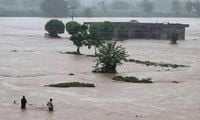Pakistan is once again on high alert as authorities warn of potential glacial floods in its northwestern regions amid an ongoing monsoon season marked by unusually heavy rainfall. The country, known for its vast glaciers—the largest outside the polar regions—is grappling with intensified weather patterns that threaten communities already vulnerable to climate change’s harsh impacts.
On Saturday, July 26, 2025, officials from the Khyber Pakhtunkhwa province issued urgent flood advisories following a surge in downpours that have exceeded those recorded during the same period last year. Anwar Shahzad, spokesperson for the provincial disaster management authority, highlighted the gravity of the situation, noting that the increased rainfall has prompted alerts specifically for flooding caused by glacial lake outburst floods (GLOFs). These floods occur when natural ice or moraine dams holding glacial lakes suddenly fail, releasing vast amounts of water downstream with devastating effects.
Adding to the concern, a letter circulated earlier this month by the disaster management authority underscored the accelerating risk posed by persistent high temperatures. The document warned that these elevated temperatures could hasten the melting of snow and glaciers, amplifying the likelihood of sudden and severe flooding in the mountainous regions. This warning reflects a broader pattern of climate change impacts in Pakistan, a country that, despite contributing minimally to global greenhouse gas emissions, remains among the most climate-vulnerable nations worldwide.
Dr. Abdul Samad of the Khyber Pakhtunkhwa Tourism Department recounted the immediate consequences of the volatile weather when a cloudburst struck overnight on Friday, July 25, 2025. The sudden downpour caused a road closure in Naran, a popular tourist destination, leading rescue teams to evacuate more than 500 holidaymakers trapped by the floodwaters. Authorities swiftly deployed heavy machinery to clear debris and restore access, underscoring the ongoing challenges in managing the aftermath of these extreme weather events.
Meanwhile, in the neighboring Gilgit-Baltistan region, the government has been actively responding to the crisis by distributing hundreds of tents, thousands of food packets, and essential medicines to communities ravaged by flooding. Spokesperson Faizullah Firaq painted a grim picture of the damage, describing “severe destruction” across several areas, including harm to houses, infrastructure, crops, and businesses. Search operations remain underway to locate missing individuals along the Babusar Highway, where floods have struck nine villages, exacerbating fears of further casualties.
Helicopter rescue missions have been crucial in reaching stranded tourists in remote locations such as Fairy Meadows, a scenic spot popular with visitors. The urgency of these operations reflects the broader difficulties faced by local authorities in balancing tourism with safety amid unpredictable weather patterns.
The region’s vulnerability was tragically illustrated earlier in the week when a cloudburst triggered floods and landslides in Gilgit-Baltistan, resulting in three deaths and stranding over 200 tourists. Zakir Hussein, director general of Gilgit-Baltistan’s Disaster Management Authority, emphasized the limits of warning systems, stating, “Generally, tourists pay attention to our warning notices. Those who still choose to come are either those who did not see the warning or those who have some urgency to visit.” He urged the public to take these predictions seriously given the potentially severe consequences.
Pakistan’s monsoon rains, while a vital source of water for agriculture and replenishing reservoirs, have increasingly come with devastating side effects. Rapid urban expansion, inadequate drainage infrastructure, and the intensification of extreme weather events linked to global warming have amplified the risks posed by seasonal flooding. The current above-average rainfall has rekindled fears of a repeat of the catastrophic 2022 floods, which submerged roughly one-third of the country, claimed 1,737 lives, and displaced over 30 million people.
So far in the 2025 monsoon season, which extends through mid-September, approximately 260 fatalities have been reported nationwide due to flooding and related incidents. With a population nearing 250 million, Pakistan faces a daunting challenge in safeguarding its citizens and infrastructure against the growing threat of climate-induced disasters.
Despite its limited role in contributing to global emissions, Pakistan's extensive glacial systems—numbering over 7,000—make it particularly susceptible to the cascading effects of warming temperatures. The melting glaciers not only threaten to unleash sudden floods but also jeopardize long-term water security for millions who depend on these natural reservoirs.
As the country braces for more rain in the days ahead, officials and communities alike remain on edge. The combination of relentless downpours, rising temperatures, and fragile infrastructure creates a precarious situation that demands vigilant monitoring and swift emergency responses. The recent evacuations, rescue missions, and relief efforts underscore the human toll of climate change’s accelerating pace in this mountainous region.
Pakistan’s experience serves as a stark reminder of the global stakes involved in addressing climate change. While the country contributes minimally to the problem, it bears a disproportionate share of the consequences. The unfolding events in Khyber Pakhtunkhwa and Gilgit-Baltistan highlight the urgent need for enhanced preparedness, resilient infrastructure, and international cooperation to mitigate the impacts of extreme weather and protect vulnerable populations.



